
Johns Smith's Map of 1612 Pre-1607 - Before the arrival of the English the Virginia Indians had been living in what is now Virginia for over 12,000 years. Chief Powhatan inherited six tribes that made up what became known as the Powhatan Chiefdom during this time. The Powhatan Indian lands encompassed all of the tidewater Virginia area, from the south side of the James River north to the Potomac River, and parts of the Eastern Shore, an area they called Tsenacommacah. Its span was approximately 100 miles by 100 miles. Before the arrival of the English, and their foreign diseases, the population is estimated to have been at least 25,000. May 1607 - When the English arrived Wahunsunacock, or more popularly Chief Powhatan, was the mamanatowick (paramount chief) of the more than 30 tribes that comprised the Powhatan Chiefdom. These additional tribes had been gained through marriage alliances and coercion. Each tribe had their own chief (weroance/weroansqua), but all were "ruled" by Powhatan and paid "tribute" to him. By this time the population of the members of the chiefdom was about 15,000 - these are the peoples the English interacted with most. 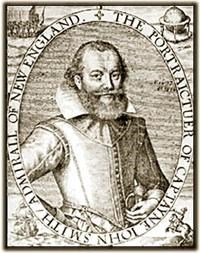
Unknown Artist Winter 1607 - Captain John Smith was captured while out exploring and taken to Werowocomoco where Powhatan lived. The two men conversed and came to an understanding of sorts and in the spring of 1608 Smith was released. Powhatan then began to send gifts of food to help the English - his young daughter Pocahontas usually accompanied these visits as a sign of peace. 1609 - Smith was injured when his gunpowder pouch caught fire and was sent home to England. With his departure relations between the Powhatan Indians and the English began to sour more rapidly. Powhatan moved from Werowocomoco to Orapaks, which was further inland, to get away from the English. 
Unknown British Museum 1610 - Pocahontas, who was now a young woman, married a Powhatan "private captain" named Kocoum. 1613 - The English kidnapped Pocahontas to try and force the return of English prisoners and stolen weapons. She was eventually taken to Henrico to live. Negotiations between the two peoples began. 1614 - While in captivity Pocahontas was taught English ways, the Christian faith and baptized Rebecca. During this time she met an Englishman named John Rolfe, who wanted to marry her. With blessings from her father and the governor, according to English accounts, the two were married. The marriage solidified a peace between the English and the Powhatan that became known as the "Peace of Pocahontas." The Rolfes later had a son, who was named Thomas. 1616 - The Virginia Company paid to send Pocahontas, her husband, their infant son and several Powhatan Indians to England. Their hope in doing so was to gain more interest in Jamestown. 1617 - Pocahontas became ill and died in Gravesend, England. After her death the peace between the Powhatan Indians and the English back in Virginia began to unravel. 1618 - Powhatan died. His succession was briefly passed on to his younger brother, Opitchapam, and then to his next younger brother Opechancanough. 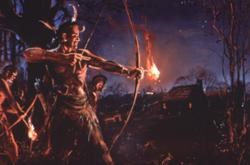
NPS image 1622 - Tired of English expansion Opechancanough planned a coordinated attack on the English settlements. Because of a young Indian boy's warning Jamestown itself was spared. Many outlying settlements were attacked and of a population of about 1,200 settlers about 350-400 were killed. After their attack, on March 22, the Powhatan Indians withdrew, as was their way, to wait for the English to pack up and leave. The English did not leave and more conflicts arose and continued on and off for the next ten years. 1646 - Opechancanough, who was about 100, was captured by the English. While in captivity he was shot in the back by an English guard - against orders - and killed. His death began the end of the Powhatan Chiefdom. 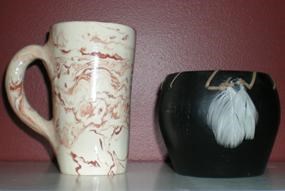
Sarah J Stebbins 1693 - The College of William and Mary was founded to teach American Indians and clergy. In the early 1700s Governor Spotswood told the Powhatan Indians he would remit their yearly tribute payments if they sent their children to the school. By the late 1700s funding for the college was diverted elsewhere and the school was closed to non-whites until 1964. 1700s - More Indian lands were lost, including the reservations of the Rappahannock (shortly after 1700), the Chickahominy (1718), and the Nansemond (who sold theirs in 1792). Some traditional ways were still practiced, but after decades of interactions with the English many Powhatan Indians were identifying themselves as Christians and speaking English more and more. By 1800 many of the native languages were no longer heard. 1800s - The desire to push the Powhatan Indians off their lands began again. This time the specific target was the four remaining Virginia Indian tribes that still held onto their reservation lands. The whites also wanted to end their status as tribes. One reservation was sold by 1850 while another, the Nottoway Reservation, was divided by 1878 (though many families held onto their lands into the 20th century). The Mattaponi and Pamunkey are the only two tribes that refused to give in to the attempts and still maintain their reservations into the present day. 1912-1946 - Walter Plecker was the head of vital statistics in Virginia during this time. He was a follower of the eugenics movement and a white supremacist. Plecker performed what amounted to "paper genocide" against all Virginia Indians because he wanted to deny they existed as he thought there were no "true" Indians in Virginia. In his view if you had 1/16th African ancestry, or by 1923 any trace of African ancestry, you were considered "colored." He wanted all documents, such as birth certificates, death certificates, marriage licenses, voter registration books, etc to reflect this by not using the term "Indian." The only two classifications according to Plecker were "white" and "colored." 1924 - The Racial Integrity Act was passed. It said, among other things, that it was illegal for whites and non-whites to marry as well as recognized only two racial classifications: "white" and "colored." Walter Plecker was a strong advocate for it as he wanted to keep the white "master race" "pure" and because he denied the existence of the Virginia Indians - who he called "mongrels." He believed the Virginia Indians wanted to escape "negro status" so they could go to white schools and marry whites. After this act was passed it was easier for Plecker to get his wish in having documents use only the terms "white" or "colored." To escape Plecker's aggressive campaign many Virginia Indians left the state. This is the same year the Indian Citizenship Act of 1924 was passed. The Act granted all American Indians United States citizenship - some had gained it previously through marriage, special treaties, receipt of allotments or through military service. 1967 - The United States Supreme Court overturned the Racial Integrity Act in the case Loving vs. Virginia saying "Under our Constitution, the freedom to marry, or not marry, a person of another race resides with the individual and cannot be infringed by the State." Virginia Indians were now able to marry who they chose and more importantly to change their birth certificates to accurately show they were Indians, for a fee. After 1997, when Delegate Harvey Morgan's bill passed, any Virginia Indian born in Virginia could have their records changed for free. 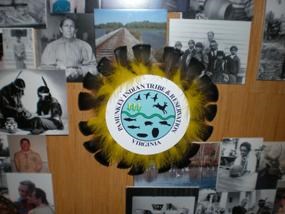
Sarah J Stebbins 1980s - By the end of the 1980s there were seven tribes recognized by the Commonwealth of Virginia who were part of, or allied with, the Powhatan Chiefdom: the Pamunkey, Mattaponi (both maintain their reservation lands from the 1600s), Upper Mattaponi, Chickahominy, Eastern Chickahominy, Nansemond, and the Rappahannock. 1990s-2009 - Six of the state recognized tribes, all but the 2 reservation tribes, began seeking federal recognition through an Act of Congress. They have tried to get the Thomasina E. Jordan Indian Tribes of Virginia Federal Recognition Act passed many times over the years. 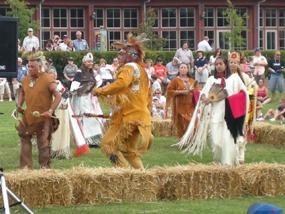
Sarah J Stebbins 2010 - In early 2010 three more tribes were recognized by the Commonwealth of Virginia: the Patawomeck, the Nottoway, and the Cheroenhaka (Nottoway). There are now eleven tribes recognized by the Commonwealth of Virginia and eight who are Powhatan descended - the Patawomeck Indian Tribe joins the seven tribes that were state recognized in the 1980s. About 3,400 people are tribal members of these eight Powhatan descended tribes. 2011 - In February, all six tribes began the process to gain federal recognition again, placing a bill in the US House of Representatives (H.R.783) and a companion bill in the Senate (S.379) on the same day. On July 28, 2011, the Senate Committee on Indian Affairs approved the Senate bill; the bill is currently waiting to be placed on the Senate legislative calendar. The House bill is currently in the House Subcommittee Indian and Alaska Native Affairs. Both bills remain in the same spot as of April 2012. If the bills do not pass by the end of 2012 (the end of this Congressional session), the tribes must start the process all over again. Bibliography Dilday, Robert. "Baptists executives urge federal recognition of Virginia tribes." AssociatedBaptistPress.com 08/19/2010. Web. 21 August 2010. Fiske, Warren. "The Black-and-White World of Walter Ashby Plecker." The Virginian-Pilot. 08/18/2004 1-7. Web. 22 May 2008. Gleach, Frederic W. Powhatan's World and Colonial Virginia: A Conflict of Cultures. Lincoln: The University of Nebraska Press, 1997. "Govtrack.us." H.R. 1385: Thomasina E. Jordan Indian Tribes of Virginia Federal Recognition Act of 2009.05/13/2009. Web. 18 March 2009 Kimberlain, Joanne. "We're Still Here." The Virginian-Pilot. June 7-9 2009: Print. "Native American Citizenship: 1924 Indian Citizenship Act." NebraskaStudies.org. Web. 24 May 2009. Rountree, Helen C. Pocahontas, Powhatan, Opechancanough: Three Indian Lives Changed by Jamestown. Charlottesville: University of Virginia Press, 2005. Rountree, Helen C. (editor) Powhatan Foreign Relations: 1500-1722. Charlottesville: University Press of Virginia, 1993. Rountree, Helen C. The Powhatan Indians of Virginia: Their Traditional Culture. Norman: University of Oklahoma Press, 1989. Rountree, Helen C. and E. Randolph Turner III. Before and After Jamestown: Virginia's Powhatans and Their Predecessors. Gainesville: University Press of Florida, 2002. "THOMAS (Library of Congress)." H.R.1385. 06/04/2009. Web. 10 June 2009. "THOMAS (Library of Congress)."S.1178. 12/23/2009. Web. 10 June 2009. "THOMAS (Library of Congress)." H.R.783. 09/29/2011. Web. 15 February 2011. "U.S. Supreme Court Loving v. Virginia, 388 U.S. (1967)." FindLaw. 1994-99. Web.3 February 2000. Wood, Karenne (editor). The Virginia Indian Heritage Trail. Charlottesville: Virginia Foundation for the Humanities, 2007.
Sarah J Stebbins Available online through the National Park Service is A Study of Virginia Indians and Jamestown: THE FIRST CENTURY by Danielle Moretti-Langholtz, Ph.D. Additional information on Virginia Indians can be obtained through the Virginia Council on Indians website at: http://indians.vipnet.org/
|
Last updated: August 24, 2020
